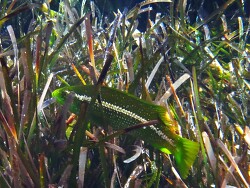Info
The photos of the wrasse, which grows to around 66 cm, were taken by Prof. Dr. Peter Wirtz and were kindly provided to us for the saltwater lexicon.
A rather delicate fish which, as far as we know, plays no role in aquaristics. If it does, it is only suitable for fish tanks. However, you must have an aquarium of several thousand liters. The fish not only grows large but also weighs up to 4.5 kilos and reaches an age of almost 30 years.
This species of wrasse feeds on almost 60% zoobenthos (benthic crustaceans, starfish, sea isopods, worms, shrimps) and about 40% nekton, especially small fish.
Ballan wrasses are used extensively as cleaner fish to control infestations of salmon lice (Lepeophtheirus salmonis) in the aquaculture industry for Atlantic salmon (Salmon salar).
Distribution
Eastern Atlantic: Norway to Morocco, including Madeira, the Azores and the Canary Islands. Doubtful records from Mediterranean, Adriatic and Marmara seas
A rather delicate fish which, as far as we know, plays no role in aquaristics. If it does, it is only suitable for fish tanks. However, you must have an aquarium of several thousand liters. The fish not only grows large but also weighs up to 4.5 kilos and reaches an age of almost 30 years.
This species of wrasse feeds on almost 60% zoobenthos (benthic crustaceans, starfish, sea isopods, worms, shrimps) and about 40% nekton, especially small fish.
Ballan wrasses are used extensively as cleaner fish to control infestations of salmon lice (Lepeophtheirus salmonis) in the aquaculture industry for Atlantic salmon (Salmon salar).
Distribution
Eastern Atlantic: Norway to Morocco, including Madeira, the Azores and the Canary Islands. Doubtful records from Mediterranean, Adriatic and Marmara seas







 Prof. Dr. Peter Wirtz, Madeira
Prof. Dr. Peter Wirtz, Madeira












